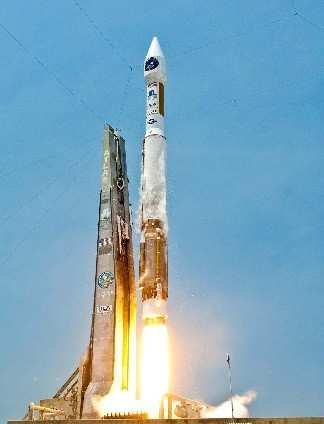Design Equivalency Review Completed For Production Launch
Vehicle
United Launch Alliance (ULA) said Tuesday it has reached a key
milestone that could lead toward the certification of the Atlas V
launch vehicle for human spaceflight. The Design Equivalency Review
(DER) completes a rigorous assessment of the flight-proven Atlas V
launch vehicle's compliance with NASA human spaceflight
requirements. Three of the four current NASA CCDev partners
providing commercial crew integrated services have selected Atlas V
as their launch vehicle. It is the second required major
performance milestone of its Commercial Crew Development (CCDev)
Unfunded Space Act Agreement.
File Photo

To successfully complete the DER, NASA human spaceflight experts
and ULA engineers worked over a span of several months to perform a
detailed review of all NASA requirements and processes, and
identified the extent to which the Atlas V meets those
requirements. Because Atlas V is already certified to fly the
nation's most complex exploration and national security missions,
the need for any lengthy and inherently risky launch vehicle
development program is expected to be avoided.
ULA has a great amount of detailed system and sub-system
qualification, certification and flight data from 27 successful
missions, which when taken together formed the basis of the DER,
according to George Sowers, vice president of business development
and advanced programs.
"The Design Equivalency Review allowed the NASA team to compare
their stringent human spaceflight requirements against the Atlas V
design and demonstrated performance," Sowers said. "The ULA team
benefited greatly from NASA's insight and expertise. The completion
of the DER is one more step towards confirming that Atlas V is the
best choice for providing near-term, safe and affordable launch
services for NASA human spaceflight."
The flight-proven Atlas V, which has already been certified to
launch high-value NASA robotic missions, reduces the risk of launch
vehicle development and early flight failures inherent in new,
unproven designs, Sowers added. "With 27 consecutive
successes—98 for the Atlas program as a whole—Atlas V
provides the highest confidence, lowest risk solution for human
spaceflight," Sowers said.

As NASA moves forward into the first phase of the Commercial
Crew Integrated Design Contract (CCIDC), ULA will offer
human-certified Atlas launch services to meet the needs for the
crew transportation system providers. "The CCIDC is the critical
first step towards creating a robust commercial crew transportation
capability to low-Earth orbit (LEO). ULA looks forward to continued
work with our customers and NASA to develop a U.S. crew space
transportation capability providing safe, reliable and
cost-effective access to LEO and the International Space Station."
Sowers said.
ULA program management, engineering, test and mission support
functions are headquartered in Denver, Colo. Manufacturing,
assembly and integration operations are located at Decatur, Ala.,
and Harlingen, Texas. Launch operations are located at Cape
Canaveral AFS, FL, and Vandenberg AFB, CA.
 ANN's Daily Aero-Linx (05.02.24)
ANN's Daily Aero-Linx (05.02.24) ANN's Daily Aero-Term (05.02.24): Touchdown Zone Lighting
ANN's Daily Aero-Term (05.02.24): Touchdown Zone Lighting Aero-News: Quote of the Day (05.02.24)
Aero-News: Quote of the Day (05.02.24) ANN FAQ: Contributing To Aero-TV
ANN FAQ: Contributing To Aero-TV NTSB Final Report: Cirrus Design Corp SR20
NTSB Final Report: Cirrus Design Corp SR20




